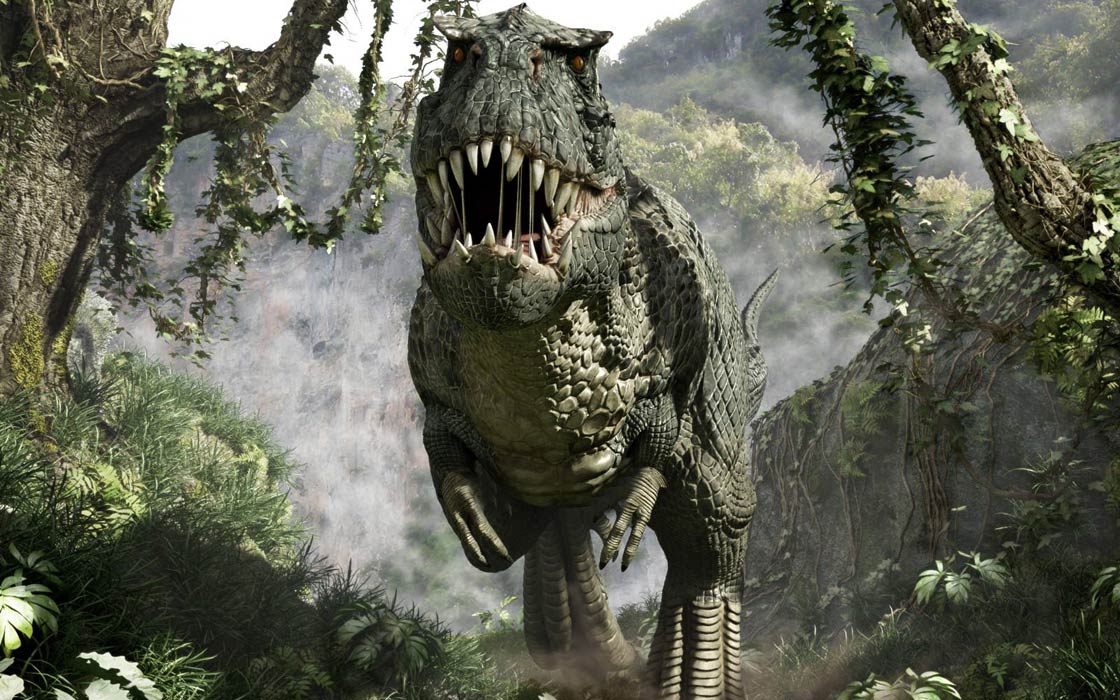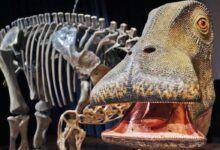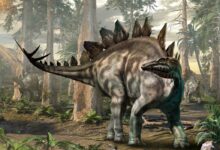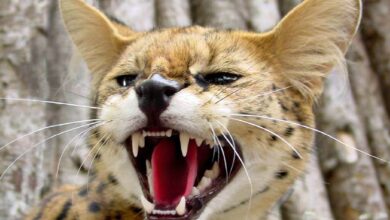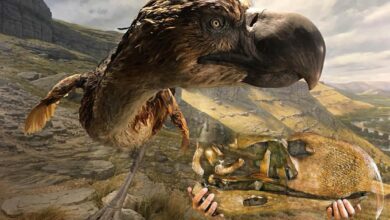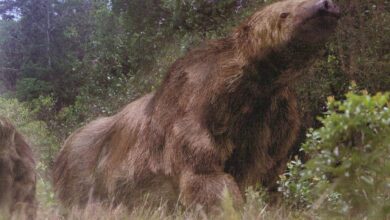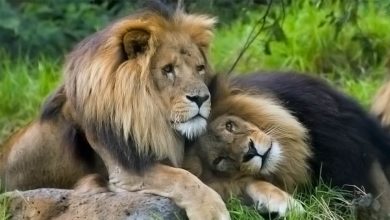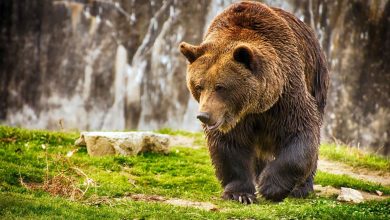Tyrannosaurus rex – a deadly force
Tyrannosaurus rex (T. rex)
The largest predator among dinosaurs
Tyrannosaurus (“lizard – tyrant”) – was one of the last and also the largest and most powerful predatory dinosaurs. The largest land carnivore of all time was heavier than an elephant and as long as the width of a tennis court. The lizard was so tall that it could see through the windows of the first floor.
Characteristic
Tyrannosaurus had a massive head (up to 1.5 m long) mounted on a flexible neck. His brain was long and narrow. He had well-developed senses of sight, hearing and smell. The forward-facing eyes made it easier for the Tyrannosaurus to accurately judge the distance as it lunged at its prey, with bared teeth in mouth open. The tips of the teeth of the upper jaw formed a curve resembling a scalpel blade.
Tyrannosaurus could pierce the hard skin of herbivores with sharp, serrated teeth and then cut off the flesh with jerky movements of the head. The largest teeth were 18 cm long and had serrated edges like a meat knife. When a worn tooth fell out, another tooth sprouted in its place.
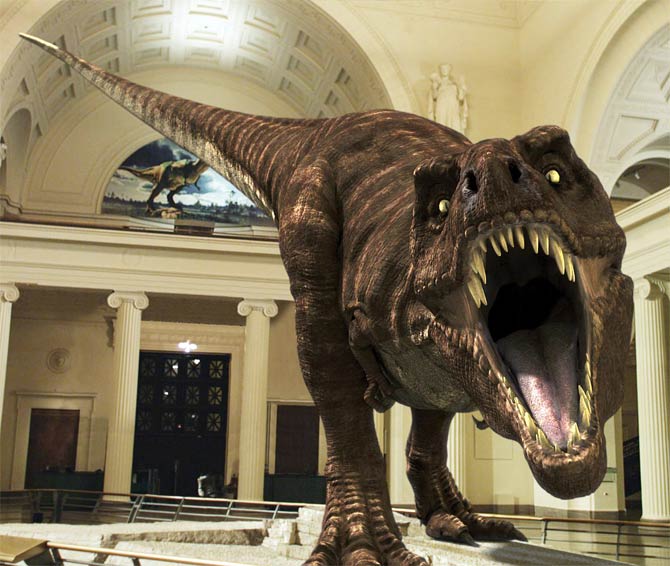
Limbs
Compared to the massive hind legs, the front paws appear absurdly tiny, no longer than human ones and tipped with 2 fingers. They look too small to be useful during an attack and too short to feed into the mouth of a tyrannosaur. We know they were well-muscled. Perhaps the animal supported them on the ground while standing up or used them as boarding hooks in confrontation with the victim.
T. rex – predator or scavenger?
Individually, in pairs, or packs, tyrannosaurs followed the wandering herds of great herbivores, waiting for the weak, young and sick. Sometimes they hunted from an ambush, catching their prey after a short chase – they could run at a speed of over 40 km / h. Most specialists, however, question such views. They consider the tyrannosaur to be a slow scavenger, although today none of the great terrestrial carnivores stop at carcass.
Most paleontologists recognize that Tyrannosaurus rex was both an active predator and a scavenger.
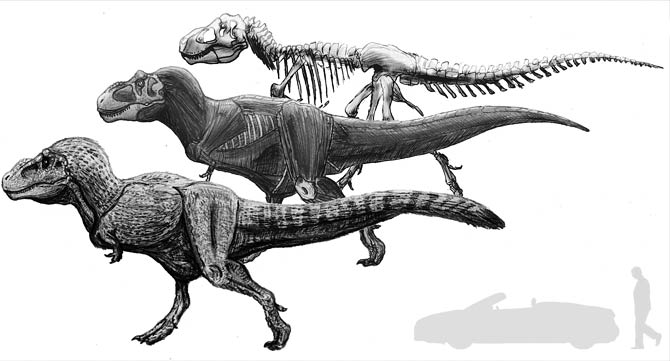
Posture
In the past, Tyrannosaurus was often incorrectly depicted with a steeply raised back, broad belly, straddling, and a snaky tail (usually dragged along the ground). We know today that Tyrannosaurus walked with his back horizontal, head raised, and body balanced by his tail pointing stiffly back.
Dinosaurs larger than T. rex
Recently, skeletons of even larger predators have been found in South America, such as Giganotosaurus / gigas (“giant”), notos (“south”), and sauros (“lizard”) – “giant southern lizard” / had a skull length of 1.83 m.
The largest known skull of T. rex (designated MOR 008), discovered in Montana in the 1960s, was about 1.5 meters long.
In the articles devoted to the largest predatory dinosaurs, we present the lists of The longest predatory dinosaurs and the heaviest predatory dinosaurs. As you can see, several reptiles were larger than the title character of today’s article.

Data / Dimensions (size)
Tyrannosaurus rex
- Length: up to 13 meters (42.7 ft)
- the largest complete skeleton (Sue) is 12.3 meters (40 ft) long)
- In 2019, a 13-meter-long (42.7 ft) Scotty skeleton was reconstructed
- Height: up to 3.66 m (12 ft) from the ground to the hip joints
- Skull: 1.5 m (4.9 ft)
- Teeth: up to 31 cm (12.2 in) including the root length. A hippo has teeth of this length.
- Weight: up to 9 tons (19,842 lb)
- Scotty 8800 kg (19,400 lb)
- Sue 8400 kg (18,519 lb)
The incomplete findings of the UCMP 118742 and UCMP 137538 (15.3 m; 16.5 tons) tyrannosaur skeletons, indicated that the T. rex could have been larger than previously thought. However, current estimates do not confirm this.
- Lifespan: about 30 years
- Speed: 17 – 40 km/h (10 – 25 mph)
- Lived: 68-66 million years ago / Late Cretaceous (Maastrichtian)
- Food: large herbivorous dinosaurs
- Occurrence: Canada, USA (South Dakota, Colorado, Montana, New Mexico, Wyoming)

Classification:
- Kingdom: Animalia
- Phylum: Chordata
- Clade: Dinosauria
- Clade: Saurischia
- Clade: Theropoda
- Family: †Tyrannosauridae
- Subfamily: †Tyrannosaurinae
- Genus: †Tyrannosaurus
- Species: †Tyrannosaurus rex

Recommended
- The longest dinosaurs. Sauropods Top 10
- The heaviest dinosaurs – Top 10
- The longest predatory dinosaurs. Theropods Top 10
- The heaviest predatory dinosaurs Top 10
- The longest Ornithischians (Ornithischia) TOP 10
- The heaviest Ornithischians Top 10
- The largest raptors (dromaeosaurs) Top 10
- The heaviest Dromaeosaurids / dromaeosaurs – Top 10
- The longest Ankylosaurus Top 10
- The heaviest Ankylosaurus Top 10
- The longest ceratopsians
- The heaviest cerapsians
- The longest and largest ornithopods
- The heaviest ornithopods Top 10
- The longest Stegosaurians (Stegosauria) TOP 10
- The heaviest Stegosaurians (Stegosauria) Top 10
- The smallest sauropods Top 10
- The smallest dinosaurs Top 10
- The largest pterosaurs Top 10
- Dinosaurs
- Dinosaurs database
- Predatory dinosaurs
- Animals & dinosaurs records
- The fastest animals – Top 100
- The fastest birds – Top 10

